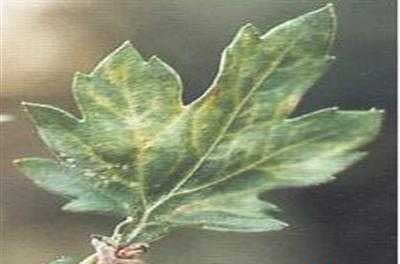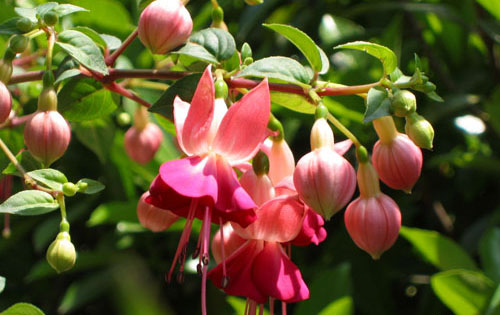What are the manifestations of violet downy mildew
Downy mildew is a major disease in violets. The disease harms the leaves, shoots and flowers of the host. At the beginning, there are light green spots on the leaf surface, and then become yellow spots. There is a white downy mildew layer on the back of the corresponding leaves. Tender shoots and flower hands are often dwarfed or deformed after infection. When the damage is serious, the leaves droop and the whole plant dies.

Planting skills of Violet
1. Reproductive characteristics
Violets are also propagated by seeds, through sowing, and then take root and sprout, blossom and bear fruit. Violet is cold-resistant and afraid of high temperature. it belongs to winter and spring plants and begins to sow after September every year. The seedlings can emerge after half a month, and blossom for 3 months.
2. Soil requirements
Violet prefers neutral and alkaline soil, if in acidic soil, it is difficult to germinate and the seeds will go bad. In addition, sudden drainage is better, and too much water accumulates, which can cause seeds to rot, or germinated violets to rot.
3. Temperature requirement
Violet is a cold-loving plant. It can grow well only in places with low temperature and good ventilation. If the temperature is relatively high or the air is relatively dry, it is easy to get disease. Violet is cold-resistant and does not like shade, so you can plant it in a place with better light.
4. Training requirements
After planting, violets need to be watered from time to time, and be careful that the amount of water is not too large; when violets take root and sprout, they need to add a little flower fertilizer after a period of time to supplement the nutrition in the soil and be careful when loosening the soil. don't destroy the rhizome, because violets are taproot plants. When the plant grows up, we should pay attention to insect control. Violets have a lot of diseases and should be prevented in time.
If you master the correct method of planting violets and know how to plant violets, you can grow beautiful violets. Put these plants on the bedroom windowsill, balcony, is also a beautiful scenery. It plays a role in embellishing our room, but violets can also get sick, so how to control violet diseases and insect pests?
Control of Violet Diseases and insect pests
Common diseases and pests in violets include downy mildew, Fusarium wilt, Verticillium wilt, mosaic, leaf spot, and diseases caused by aphids. Do not see do not know, a look is really startled, a small plant, there will be so many diseases. So how to control Violet diseases and insect pests? What are the correct methods?
1. Control of downy mildew.
The disease is mainly caused by germs in the soil that infect the roots, which can be caused by over-dense sowing or poor drainage. The disease is the appearance of light green spots on the leaves, yellowing in the later stage, and a white frost layer on the back. Prevention and control methods are: Violet sowing gap is slightly larger, to ensure good ventilation, pay attention to drainage, the water content in the soil is appropriate. For diseased plants, it is necessary to remove them in time and spray a little fungicide aqueous solution around them.
2. Control of Fusarium wilt.
Fusarium wilt is caused by Fusarium oxysporum. Its symptoms are as follows: the plant becomes shorter and shrinks, there are obvious veins on the leaves of the young plants, and the leaves of the larger plants are sagging. Control method: soak the seeds in warm water of 50-55 degrees for a few minutes to kill germs, while the soil can be disinfected with 1000 times potassium permanganate solution before planting. Plants that have been infected need to be removed in time.
3. Prevention and treatment of mosaic disease
Mosaic disease is caused by Daphne mosaic virus, which is transmitted by aphids and can also be transmitted by juices. Control method: the infected plants need to be isolated in time, and then sterilized with 1.2% nicotinine 2000-4000 times solution.
4. Pest control
Insect pests are mainly caused by aphids, which pierce into the plant tissue to absorb juice, making the damaged parts appear macula or black spots, while the damaged leaves will atrophy and fall off in the later stage, and the buds will also be deformed. Control method: remove weeds around the plant, spray 40% dimethoate or omethoate 1000-1500 times solution to kill insects.
The prevention and control of the above several kinds of violet diseases and pests are only common plant diseases, and there are other plant diseases that we need to understand and do a good job in prevention and control. Do a good job in the prevention and control of diseases and insect pests in time, let violets grow healthily and bloom beautiful flowers, while you harvest the beautiful scenery, you also get a small sense of achievement.
After reading the above introduction on violet planting techniques and pest control, do you know more about violet planting techniques? if you want to know more about violet planting techniques, please continue to pay attention.
Prevention skills of Violet Diseases and insect pests in preventing and controlling Plant Diseases
Common diseases and pests in violets include downy mildew, Fusarium wilt, Verticillium wilt, mosaic, leaf spot, and diseases caused by aphids. Do not see do not know, a look is really startled, a small plant, there will be so many diseases. So how to control Violet diseases and insect pests? What are the correct methods? Let's get to know it.
The main results are as follows: 1. The prevention and control of downy mildew is mainly due to the infection of bacteria in the soil, which can be caused by over-dense sowing or poor drainage. The disease is the appearance of light green spots on the leaves, yellowing in the later stage, and a white frost layer on the back. Prevention and control methods are: Violet sowing gap is slightly larger, to ensure good ventilation, pay attention to drainage, the water content in the soil is appropriate. For diseased plants, it is necessary to remove them in time and spray a little fungicide aqueous solution around them.
2. The control of Fusarium wilt is caused by Fusarium oxysporum. The symptoms are as follows: the plant becomes shorter and shrinks, there are obvious veins on the leaves of the young plants, and the leaves of the larger plants droop. Control method: soak the seeds in warm water of 50-55 degrees for a few minutes to kill germs, while the soil can be disinfected with 1000 times potassium permanganate solution before planting. Plants that have been infected need to be removed in time.
3. Prevention and control of mosaic disease caused by Daphne genkwa mosaic virus, which is transmitted by aphids and can also be transmitted by juice. Control method: the infected plants need to be isolated in time, and then sterilized with 1.2% nicotinine 2000-4000 times solution.
4. The prevention and control of insect pests is mainly caused by aphids. Aphids pierce into the plant tissue to absorb juice, making the damaged parts appear macula or black spots, while the damaged leaves will shrink and fall off in the later stage, and the buds will be deformed. Control method: remove weeds around the plant, spray 40% dimethoate or omethoate 1000-1500 times solution to kill insects. The prevention and control of the above several kinds of violet diseases and pests are only common plant diseases, and there are other plant diseases that we need to understand and do a good job in prevention and control. Do a good job in the prevention and control of diseases and insect pests in time, let violets grow healthily and bloom beautiful flowers, while you harvest the beautiful scenery, you also get a small sense of achievement.
| | Family Garden | sunken Garden | balcony Garden | |
- Prev

What harm does chrysanthemum virus disease have?
Virus disease is an important disease in chrysanthemum cultivation, which is widely distributed. Chrysanthemum virus diseases occur all over China, including chrysanthemum infertility virus, chrysanthemum mosaic disease, chrysanthemum malformation disease and so on. 1. The pathogen of chrysanthemum infertility virus is tomato infertility virus.
- Next

How to prevent and cure root rot disease of inverted golden bell
1, with good drainage of the new soil cultivation inverted bell, there are bacteria soil should be steam sterilization, or with the enemy structure treatment. 2. Scientific watering. Small amounts of water should be irrigated frequently, and large amounts of water should be avoided. Basin soil is too wet for a long time, root system suffocation, also easy to rot. 3. Clear the diseased body in time, pull out the seriously diseased plant, and burn it completely.
Related
- Fuxing push coffee new agricultural production and marketing class: lack of small-scale processing plants
- Jujube rice field leisure farm deep ploughing Yilan for five years to create a space for organic food and play
- Nongyu Farm-A trial of organic papaya for brave women with advanced technology
- Four points for attention in the prevention and control of diseases and insect pests of edible fungi
- How to add nutrient solution to Edible Fungi
- Is there any good way to control edible fungus mites?
- Open Inoculation Technology of Edible Fungi
- Is there any clever way to use fertilizer for edible fungus in winter?
- What agents are used to kill the pathogens of edible fungi in the mushroom shed?
- Rapid drying of Edible Fungi

